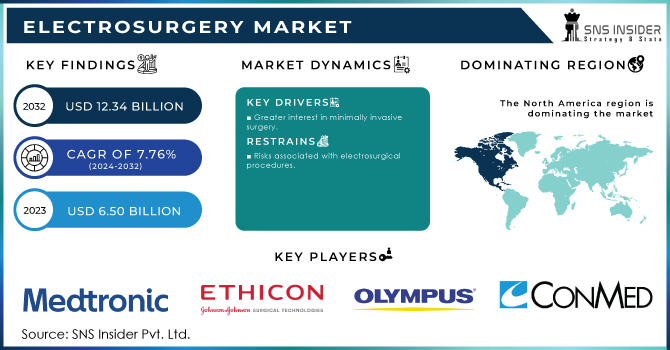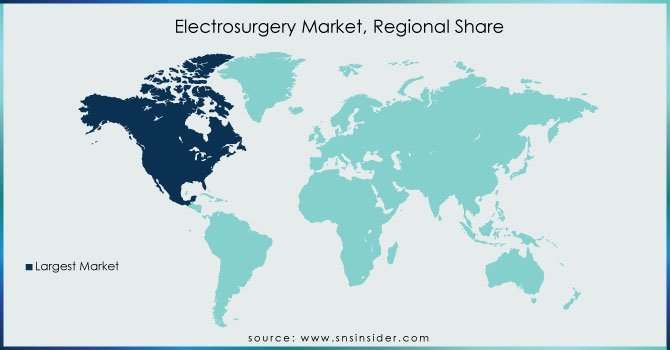Electrosurgery Market Scope & Overview:

To Get More Information on Electrosurgery Market - Request Sample Report
The Electrosurgery Market Size was valued at USD 6.50 Billion in 2023 and is expected to reach USD 12.34 Billion by 2032 and grow at a CAGR of 7.76% over the forecast period 2024-2032.
The market is growing as a result of the increase in chronic illnesses and lifestyle disorders that can be treated, including by undergoing repeated procedures. The sales of new minimally invasive surgery techniques and integrated technology in the world market Other devices and generators are part of it. Electrosurgery's risks and benefits determine if treatment is worth it. global market trends for the foreseeable future. An examination of the industry on a global scale reveals that age-related cosmetic electrosurgeries utilize novel methods. Electrosurgery equipment sales are mostly driven by surgeries and healthcare facilities. The expansion of the electrosurgery equipment market is also related to the rise in ambulatory surgical facilities.New, cutting-edge technology is being embraced by governments all around the world to improve healthcare systems.
MARKET DYNAMICS
DRIVERS
-
Greater interest in minimally invasive surgery.
The inclination for non-invasive and minimally invasive surgical procedures has significantly increased during the past ten years. Procedures over standard surgical ones. Over open surgical techniques, minimally invasive surgeries have a number of advantages, including shorter hospital stays, fewer post-operative problems, quicker healing, greater effectiveness, and decreased pain. Additionally, these techniques are less expensive than standard surgical procedures. Technologies like lasers and electrosurgery are becoming more and more popular in place of traditional surgical methods for the treatment of a number of illnesses, such as liver cancer, heart valve issues, eye problems, and spine operations. This is mostly due to their procedural advantages over ordinary surgery.
RESTRAIN
-
Risks associated with electrosurgical procedures.
OPPORTUNITY
-
Increasing government support for the development of sophisticated medical therapies.
CHALLENGES
-
Worries about the harmful gases released during operations
By thermally destroying tissue with lasers or electrosurgical tools, surgical smoke is created. Surgical smoke has been demonstrated to contain hazardous gases, vapors, particles, viable and non-viable cellular material, viruses, and germs, in addition to being an annoyance due to its offensive odor and ability to obscure the surgeon's view of the surgical site. It has been proven that surgical smoke from lasers can spread the human papillomavirus (HPV). Each year, surgical smoke is inhaled by more than 500,000 healthcare professionals, including surgeons, nurses, and surgical technologists.
IMPACT OF ECONOMIC SLOWDOWN
Governments, healthcare institutions, and individuals may face financial constraints as a result of reduced healthcare spending during a recession. This could result in reduced healthcare spending, influencing hospital and healthcare facility purchasing decisions. As healthcare providers prioritize vital services and cost-cutting initiatives, demand for electrosurgical devices, which are generally expensive and considered capital investments, may fall. Postponed or Reduced During a recession, hospitals and medical facilities may postpone or cut their procurement of electrosurgical equipment. As healthcare providers focus on managing immediate financial issues, capital-intensive expenditures such as electrosurgery instruments may be postponed. The Effect on Research and Development During a recession, medical device makers may experience difficulties supporting research and development initiatives. This could stifle innovation and the development of new and improved products.
KEY MARKET SEGMENTATION
By Product
-
Electrosurgical Instruments
-
Electrosurgical Generators
-
Electrosurgical Accessories
-
Smoke Evacuation Systems
By Surgery
-
General Surgery
-
Obstetric/Gynecological Surgery
-
Orthopedic Surgery
-
Cardiovascular Surgery
-
Oncological Surgery
-
Urological Surgery
-
NeuroSurgery
-
Other Surgeries
By End User
-
Hospitals, Clinics, and Ablation Centers
-
Research Laboratories and Academic Institutes
REGIONAL ANALYSES
North America had established itself as the market leader for electrosurgery, thanks to the presence of a local industry, technological breakthroughs, and competitive dynamics. With a substantial market share, the United States is expected to continue to have an impact on the sector thanks to its friendly regulations, strong economy, and well-established healthcare sector.
The Asia Pacific region is primed for expansion, driven by brisk economic growth, rising foreign direct investments, and rising public knowledge of state-of-the-art surgical equipment. Significant prospects for business expansion and innovation exist in this region.

Do You Need any Customization Research on Electrosurgery Market - Enquire Now
REGIONAL COVERAGE
North America
-
US
-
Canada
-
Mexico
Europe
-
Eastern Europe
-
Poland
-
Romania
-
Hungary
-
Turkey
-
Rest of Eastern Europe
-
-
Western Europe
-
Germany
-
France
-
UK
-
Italy
-
Spain
-
Netherlands
-
Switzerland
-
Austria
-
Rest of Western Europe
-
Asia Pacific
-
China
-
India
-
Japan
-
South Korea
-
Vietnam
-
Singapore
-
Australia
-
Rest of Asia Pacific
Middle East & Africa
-
Middle East
-
UAE
-
Egypt
-
Saudi Arabia
-
Qatar
-
Rest of Middle East
-
-
Africa
-
Nigeria
-
South Africa
-
Rest of Africa
-
Latin America
-
Brazil
-
Argentina
-
Colombia
-
Rest of Latin America
Key Players
The major players are Medtronic, Ethicon US, LLC., Olympus Corporation, CONMED Corporation, Erbe Elektromedizin GmbH, Bovie Medical Corporation, Braun Melsungen AG, BOWA-electronic GmbH & Co. KG, Kirwan Surgical Products, LLC., Parkell, Inc, and others.
RECENT DEVELOPMENTS
Ethicon, Inc: In 2022, Ethicon, Inc. (US) (J&J) introduced an electrosurgical generator for use in different open and laparoscopic procedures. It is a microprocessor-controlled high-frequency generator with an isolated output that can perform bipolar and monopolar coagulation with the addition of a second electrode.
Medtronic: In 2022, order to improve patient treatment experiences and general outcomes, Medtronic (Ireland) and DaVita Inc. (US) collaborated to create a new, independent medical device firm ("NewCo" or "the Company") focusing on kidney care.
| Report Attributes | Details |
| Market Size in 2023 | US$ 6.50 Bn |
| Market Size by 2032 | US$ 12.34 Bn |
| CAGR | CAGR of 7.76% From 2024 to 2032 |
| Base Year | 2023 |
| Forecast Period | 2024-2032 |
| Historical Data | 2020-2022 |
| Report Scope & Coverage | Market Size, Segments Analysis, Competitive Landscape, Regional Analysis, DROC & SWOT Analysis, Forecast Outlook |
| Key Segments | • By Product (Electrosurgical Instruments, Electrosurgical Generators, Electrosurgical Accessories, Smoke Evacuation Systems) • By Surgery (General Surgery, Obstetric/Gynecological Surgery, Orthopedic Surgery, Cardiovascular Surgery, Oncological Surgery, Cosmetic Surgery, Urological Surgery, NeuroSurgery, Other Surgeries) • By End User (Hospitals, Clinics, and Ablation Centers, Ambulatory Surgical Centers, Research Laboratories and Academic Institutes) |
| Regional Analysis/Coverage | North America (US, Canada, Mexico), Europe (Eastern Europe [Poland, Romania, Hungary, Turkey, Rest of Eastern Europe] Western Europe] Germany, France, UK, Italy, Spain, Netherlands, Switzerland, Austria, Rest of Western Europe]). Asia Pacific (China, India, Japan, South Korea, Vietnam, Singapore, Australia, Rest of Asia Pacific), Middle East & Africa (Middle East [UAE, Egypt, Saudi Arabia, Qatar, Rest of Middle East], Africa [Nigeria, South Africa, Rest of Africa], Latin America (Brazil, Argentina, Colombia Rest of Latin America) |
| Company Profiles | Medtronic, Ethicon US, LLC., Olympus Corporation, CONMED Corporation, Erbe Elektromedizin GmbH, Bovie Medical Corporation, Braun Melsungen AG, BOWA-electronic GmbH & Co. KG, Kirwan Surgical Products, LLC., Parkell, Inc |
| Key Drivers | • Greater interest in minimally invasive surgery. |
| Market Restraints | • Risks associated with electrosurgical procedures. |

